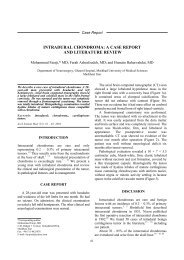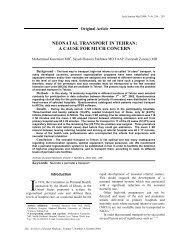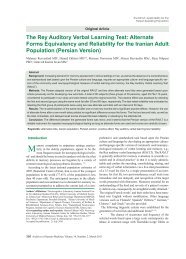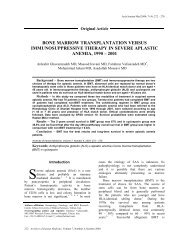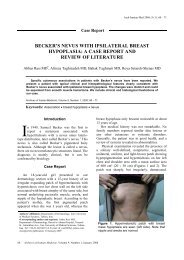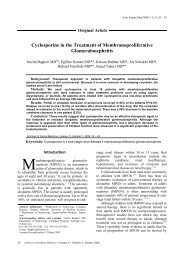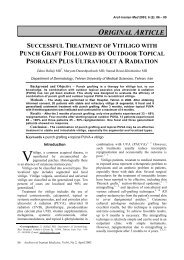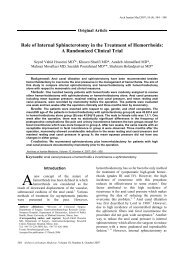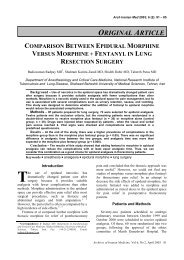MEDICINE AND PUBLIC HEALTH IN QAJAR ERA; IRAN
MEDICINE AND PUBLIC HEALTH IN QAJAR ERA; IRAN
MEDICINE AND PUBLIC HEALTH IN QAJAR ERA; IRAN
You also want an ePaper? Increase the reach of your titles
YUMPU automatically turns print PDFs into web optimized ePapers that Google loves.
Arch Iranian Med 2005; 8 (3): 239 – 240Book Review<strong>MEDIC<strong>IN</strong>E</strong> <strong>AND</strong> <strong>PUBLIC</strong> <strong>HEALTH</strong> <strong>IN</strong> <strong>QAJAR</strong> <strong>ERA</strong>; <strong>IRAN</strong>Mohammad-Hossein Azizi MD •The Qajar dynasty (1794 – 1925) in Iranwas preceded by the late 18 th centuryZands. Historically, the second half ofthe 19 th century is the beginning of modernizationin Iran. Mirza Taqhi Khan Amir Kabir, the ChiefMinister of Naser-ad-Din Shah Qajar, the fourthking of Qajar dynasty, was a great reformist whowas heavily involved in Iran’s modernizationprocess including medicine. The foundation ofDar-al-Fonun (i.e. House of Techniques), the firstmodem higher educational institution in 1851, isconsidered as one of the most important efforts ofAmir Kabir. The students were mainly taught byEuropean teachers with aid of local translators. 1According to Dr. Floor, Iran in the Qajar erahad a total population of around five million in1800 that rose to almost nine million in 1900. Themajority of the population was rural and engagedin agriculture. By 1900, the urban population hadmore than doubled and represented some 18% withthree towns having more than 100,000 inhabitants:Tehran with about 280,000, Tabriz with 200,000,and Isfahan with 100,000. Four other towns hadeach 50,000 inhabitants or more. The people inAuthor’s affiliation: ENT Private Clinic, Tehran, Iran.•Corresponding author and reprints: Mohammad-HosseinAzizi MD, Second Floor, No. 6, Amir Ebrahimi St., Boostane 2,Pasdaran Ave., Tehran, Iran.Telefax: +98-21-2534338, E-mail: f_azizi2000@yahoo.com.Iran in Qajar period suffered from a broad range ofdiseases. 2The historiography of medicine in Iran hasusually focused on what, the so-called “the GoldenAge of the Persian Medicine,” i.e. the periodbetween the 9 th and 14 th centuries. 3The 19 th century, however, has only beenstudied scarcely. Until recently, there have been nobooks and only a few papers available in Englishthat dealt with actual picture of medicine andpublic health in 19 th and early 20 th century inIran. 2,3Fortunately, currently two valuable books arepublished in English on the above-mentionedsubject. They are:The book entitled “Medicine, Public Health andQajar State—Pattern of Medical Modernization inNineteenth Century Iran” by HormozEbrahimnejad, PhD in history from University ofSorbonne, Paris. The book provides surprising newinsight into the interrelation of medical practice,and public health during Qajar dynasty in Iran.This 263-page book consists of two major parts: 1)“The institutional and theoretical changes intraditional medicine” and 2) “On the benefits, themaintenance, and the Statutes of State Hospital.”The “State Hospital” or “Marizkhaneh-yeDowlati” was the first modern hospital in Tehran,opened in 1852. 3 Each part is divided into multiplechapters, covering a wide range of topics andprovides a clear information on the public healthand medicine in Iran during the 19 th century.Part one has the following chapters:Chapter 1: a cursory review of hospitalsincluding hospitals in the prehistoric era andantiquity, Islamic period, organization andadministration;Chapter 2: public health and sociopoliticalchanges;Chapter 3: the manuscript, the author, and thehospital;Archives of Iranian Medicine, Volume 8, Number 3, July 2005 239
Book reviewFigure 1. Manuscript 505 on the establishmentof public hospitals in Iran. 3Chapter 4: traditional medicine and modernization;andChapter 5: towards the epistemology of medicalmodernization.Part two consists of 13 sections. They aredevoted to an anonymous Persian manuscript. Thismanuscript discusses the establishment of the“State Hospital” or “Marizkhaneh-ye Dowlati” inTehran. A copy of this manuscript is available atthe Iranian Parliament Library (Majles Library)(Figure 1). A Persian text of this manuscript(Manuscript 505) is included in the Dr.Ebrahimnejad’s book.At the end, a useful bibliography and name andsubject indices are provided. There are also eighthistorical illustrations. 3Another book entitled "Public Health in QajarIran" is written by Willem Floor with doctoraldegree from University of Leiden who studieddevelopment economics, nonwestern sociology aswell as Persian and Arabic, and Islamology. Dr.Floor has published extensively on thesocioeconomic history of Iran. 2 His present studyon medicine and public health in Qajar era in Iranprovides the readers an overview of publichygiene, major prevalent diseases, and practice ofmedicine at that time. Dr. Floor has drawn the datanecessary for his research mainly from thoseEuropean observers who have reported on actualpractice of medicine, prevalence, and treatment ofdiseases during Qajar dynasty. Most of theseobservers were physicians who had practicedmedicine in Iran. The book consists of sixchapters:Chapter 1: introduction;Chapter 2: main diseases;Chapter 3: public hygiene;Chapter 4: medical knowledge;Chapter 5: medical institutional infrastructure;andChapter 6: the progress of modern medicine.At the end of this book, there are threeappendices, a bibliography, and an index. Thebook concludes with impact of western medicineon the traditional medicine institutions and publichealth in Qajar era in Iran. Some historical picturesare also added to the text. 2References1 Kiddie NP. Modern Iran, Root and Results of Revolution.New Haven and London: Yale University Press; 2003:48 – 49.2 Floor W. Public Health in Qajar Iran. Washington, DC:Mage Publishers; 2004: 11.3 Ebrahimnejad H. Medicine, Public Health and QajarState, Pattern of Medical Modernization in NineteenthCentury Iran. Leiden-Boston: Brill Publication; 2004: 5.240Archives of Iranian Medicine, Volume 8, Number 3, July 2005



